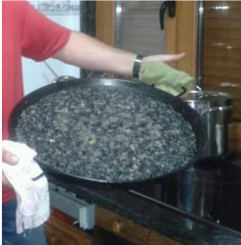
Spanish Paella Tradition: An Authentic Asturian Paella Recipe
GETTING TO KNOW THE SPANISH THROUGH PAELLA
Paella is a traditional dish from the Community of Valencia. Basically, it consists of rice as well as anything else that you fancy. The dish is prepared in an enormous pan with handles called a paella, in the Valencian language. In the rest of Spain, it’s known as a paellera.
In most Spanish households, paella is eaten on a weekly basis, especially on Sundays. The family gets together and the kitchen is awash with flavors and ancestral wisdom. Even though a good part of the weekly budget goes to ingredients, no one complains, and, when everyone digs in, the investment is considered well-spent. The culture of different Spanish autonomous regions can be defined by this well-known dish and at just a glance, the ingredients can tell us where the chef hails from.
Regional Paella Varieties
Let’s take as an example the Alvarez family. Manolo, the father, is from Murcia, a sunny region on the Mediterranean coast, rich in fertile land and endowed with enormous fields of fruits and vegetables. Covadonga, the mother, is from Asturias, a mountainous province in the north of Spain bordered by the wild Cantabrian Sea. Asturias has access to the best fish and seafood on the peninsula.
When the Alvarez family invites you over for a paella, the only thing that you can be sure of is that you are going to be served rice, whatever else they add depends on who has tomado las riendas (taken the reins) in the kitchen that day. No one argues with the chef.
Murcian Paella
If Manolo is preparing the paella a surprising variety of ingredients are mixed together in the enormous pan: rice, tomatoes, artichokes, red peppers, saffron, thyme, rosemary and white wine. This is just to start. Later he adds the principal ingredients, rabbit and escargot. Yes, snails. A typical paella like this from Murcia isn’t complete without salsa alioli, a mixture of olive oil and garlic. Wonderful.

Asturian Paella
But that’s just one version. When Covadonga from Asturias takes over the kitchen la cosa cambia, (things change). You may have to look to the depths of the ocean to find a grain of rice. Prawns, scampi y langoustine have the place of honor, accompanied by mussels, clams and fried squid.
This exquisite seafood is added to a base of tomato, peppers, and onion, along with rice infused with saffron. And to placate guests who are getting a bit hungry, – “algo muy habitual en las madres españolas” (not an uncommon occurrence among Spanish mothers), there’s always a big plate of spare ribs lightly fried in olive oil that also goes into the paella.

If you ask either of the chefs whose paella is the best, and the most authentic, they’ll argue with you till the ends of the earth that’s it theirs. They’ll tell you about the other, “no tiene chicha” (it’s bland and flavorless). Covadonga will also complain about “la pila de cacharros” (the sink full of dishes) that she has to wash. In the Alvarez family, the chef never does the washing up.
Socarrat
But both paellas have something in common, called “socarrat” in Valenciano. The crunchy rice that sticks to the bottom of the pan and which is considered a delicacy. You may want to take a step back when the family starts to fight over who gets to scrape the bottom of the pan.
But regardless how well you’ve eaten, if a Valenciano shows up he or she will swear that the dish you’ve just eaten is not, in fact, paella. To a Valenciano, the only authentic paella is to be found just below the Miguelete (the heart of Valencia). If it doesn’t have chicken, green beans and garrafón, a white bean native to Valencia, you haven’t had an “authentic” paella.

Authentic Asturian Paella Recipe
My mother is a great cook with a strong personality, which means that she makes paella the way she wants to, sin complejos (without hang-ups). She’s well-traveled and is familiar with several ‘authentic’ recipes. She’ll also improvise using whatever ingredients happen to be in the refrigerator.
This is the paella my family eats on any given Sunday.
Ingredients
- Rice – 1/3 cup uncooked Valencian Bomba Rice per person
- Pork ribs. Approximately one rib per person. (a half-chicken cut into pieces can also be used instead of pork).
- Clams – a handful
- Clove garlic
- Prawns – one or two per person
- 1 lemon
- ½ red pepper
- ½ green pepper
- A few strands of saffron per person
- Teaspoon of paprika
- A dash of white wine
- Salt
- Water (two cups for every cup of rice)
- Bell pepper to garnish.
Preparation / Instructions
- Soak the clams in cold water for several hours before starting to remove any sand. Move them around every so often.
- IN THE PAELLERA (a large, shallow pan specifically used to prepare paella). First, prepare the ribs by cutting them into 4-5 cm pieces. Season with salt and finely chopped garlic. Lightly fry the meat in olive oil until golden brown. Stir with a wooden spoon.
- Chop the peppers into pieces a centimeter in size and add them to the paellera with the ribs. Fry over low heat until the peppers are soft. When ready, add a dash of White wine and let simmer until the wine evaporates.
- IN A POT – At the same time, peel and de-head the prawns. Put the shells and the heads into a pot of boiling water. To calculate the correct amount of water, use two measurements for every one of rice. After boiling for five minutes strain the water and set it aside. ¡No la tires! Don’t throw it away! It will be used later.
- MORTAR AND PESTLE – Put the shells and heads into a mortar and crush them with the pestle to extract all the juices. Strain and set juice aside.
- PAELLERA- Add the concentrated prawn juice to the paellera along with the strands of saffron and the teaspoon of paprika. Stir slowly.
- Now is time to add the rice. (Experienced chefs who can calculate the exact quantity of rice correctly, measure it by a puñados, the handful, and they sprinkle it into the paellera by hand). Spread it evenly throughout the pan and stir with the sauce and the meat until it is well-mixed.
Note: You can use a wooden spoon to stir, however using any utensil to add the rice, other than your hand, will bring upon you a curse. Anyone watching you prepare the paella will shout, …pero, ¡qué haces! What are you doing!
- Next add the water that was used to boil the prawns and move the pan around por las asas, by its handles, to distribute it evenly throughout. Add a pinch of salt.
- When the water begins to boil, squeeze the half lemon over the whole dish. This helps to stop the rice from sticking together.
- At minimum heat, place the clams and prawns on top of the rice. Ponle arte, (be creative) so that it looks appealing.
- Cook over low heat for 20 minutes.
- Remove the paellera from the burner and cover it with either a lid or a cloth to absorb any remaining moisture.
- Before serving, you can add a few slices of bell pepper to any free space of the paella to give it a bit more color and add to the presentation. Half a lemon can be placed in the middle.
It’s now ready! Paella is normally accompanied by a salad of lettuce, tomato, and onion.
IMPORTANT: The burner used to cook the paella should cover as much as the base of the pan as possible. If you don’t have a large ring burner (these can be bought specifically made for cooking large paellas) you can use several smaller ones and turn the pan every so often to ensure that everything is cooked a la par, evenly. It’s a lot of fun and not very complicated.
Learn to Speak Spanish – Don’t Just Study it
Because learning a new language is not about how many words you know, how many grammar rules you’ve learned, or how many catchphrases you’re able to memorize. It’s about understanding what you hear and responding easily and naturally.
Try the Full Pimsleur Spanish Premium Course for 7 days Free! Only $19.95/month thereafter.